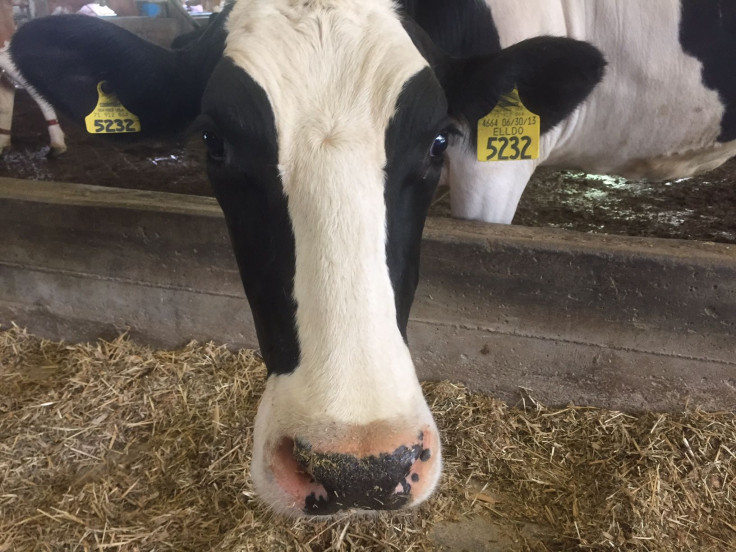4 Things I Learned About Milk And Cows After Visiting A Dairy Farm

Last week, I traveled two hours north from New York City to visit a dairy farm where I got to see exactly how milk made its way from the cows’ udders to the carton in my supermarket. Not only was this process far shorter than I realized, with the milk I drink coming from a cow only days before, but it involved fewer steps than I thought.
Milk consumption in America has been declining for decades, with everything from the “fear of fat” causing consumers to stay away from dairy, to exciting new dairy alternatives such as almond and coconut milk taking its place. People also believe that modern dairy farming practices have made milk less natural and healthy than the milk our grandparents drank. My visit to Coon Brothers Farm in Amenia, NY taught me that some of the beliefs we have about milk are past their expiration date, at least for smaller farms like the one I visited. Here are four things I learned on my trip.
Milk Goes From Cow To Shelf Really Fast
The cows on the farm are milked twice a day; once early in the morning before dawn and then again in the afternoon. The milking process is completely mechanical, and so I expected to see barns overcrowded with cows pushed into uncomfortable machines. Instead, I saw only a handful of relaxed cows walking to milking machines at their leisure. Once at the machines, the cows' udders were disinfected before they were milked. The actual milking process took only a few minutes, and soon the cows were left to once again roam their spacious, clean barn.
Read: Does Milk Actually Build Strong Bones? Sugar Content May Lead To Greater Fracture Risks
Once the milk is collected, it's pasteurized, bottled, and sent to grocery stores, just as quick as that.

These Cows Have A Good Life
I’ve heard horror stories of animal mistreatment in large-scale industrial farms, from chickens being thrown into grinders while still alive, to cows being milked to the brink of death with no regard for their health. However, to my surprise (and relief), the animals at Coon Brothers Farm were anything but stressed.
The animals had space to roam and run if they wanted to, both inside and outside of their barns. The barns were neither crowded nor dirty. In fact, the animals even had mattresses to lie on to escape the summer heat. Of course, not every farm operates like this one, but these cows were living the good life.
Organic Isn’t Always As Good As It Sounds
The cows on the Coon Brothers Farm may occasionally receive antibiotics and hormones, which prevents them from being labeled as organic.
“We try not not use antibiotics, but if a cow gets sick, we’re going to help it,” our guide, Peter Coon, one of the brothers of the farm, said to the tour group, explaining why the drugs may be necessary in some cases. The farm only treats cows with medication when recommended by a vet, and at any given time there were never more than two or three cows being treated. Infections and disease can occur no matter how careful you are, and without antibiotics, these animals would be left to suffer from easily treatable infections.
The cows are tested to make sure they don’t have antibiotics in their system before they are milked again, and even after this, the milk is once again tested to ensure that it also has no antibiotics in it, Coon explained.
As for hormones, these are used only in rare circumstances to help cows get pregnant after many failed attempts.
So no, these cows aren’t organic, but if you’ve ever received medication for an illness or hormones to either prevent or encourage pregnancy, neither are you.
Milk Isn’t The Only Form Of Protein, But That Doesn’t Make It A Bad Choice
According to NPR, one of the reasons that milk has fallen out of favor among Americans is an increase in nutrient choices. Milk alternatives abound, including soy, almond, and coconut, to name a few; there are also countless ways for Americans to get their protein intake.
Still, just because there are more choices for getting vital nutrients into your body, it doesn’t make milk a bad one. In addition to protein, milk also contains vitamin D, calcium, potassium, vitamin B12, vitamin A, riboflavin, phosphorus, and niacin, Milk Life reported.
Sure, milk isn’t perfect. It does have saturated fat, the “bad fat” according to some nutritionists, and the link between milk and lowered osteoporosis risk has been recently called into question. It remains an excellent and delicious source of protein and other important nutrients. While it may not be as sexy or cool as newer milk alternatives, it’s no less healthy, depending on your measure, and has shown its worth as a staple in any balanced diet.
See Also:
Here’s How Milk Is Made And Why We Are So Obsessed With Dairy
Whole Milk And Full-Fat Dairy May Help You Maintain Weight, Reduce Diabetes Risk



























